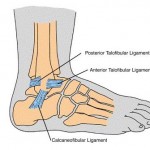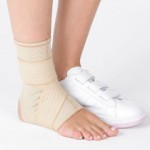What is it?
If you have suffered an inversion ankle sprain, it means you have injured one or more of the three main ligaments on the outside of your ankle; the anterior talofibular ligament (ATFL), the posterior talofibular ligament (PTFL) and the calcaneofibular ligament (CFL). The job of a ligament is to join bone to bone and provide stability to a joint. Inversion ankle sprains are also associated with injury to surrounding musculature and can be associated with injury to the capsule surrounding the joint, or even a fracture if the injury is severe enough.

Grades of ankle sprains
There are different grades of an inversion ankle sprains.
A grade 1 sprain involves injury to only one of the three ligaments on the outside of your ankle. With a grade 1 sprain the ligament has been overstretched, there is minimal to no tearing of the ligament, and the ankle remains stable.
A grade 2 sprain occurs when either one of the three ligaments has been fully torn or two of the three ligaments have been partially torn. With a grade 2 sprain the ankle joint will suffer from some instability.
A grade 3 sprain will cause your ankle to be the most unstable and occurs when two of the three ligaments (usually the ATFL and CFL) are completely torn.
How does it happen?
The lateral ligaments of your ankle are put on stress if your foot rolls inwards. The inwards rolling of your foot will put the ligaments on the outside of your ankle on stretch and possibly cause them to tear. One common way that inversion sprains occur is from landing a jump; especially if landing on an uneven surface such as another foot or matt, as might happen in sports like basketball, volleyball and gymnastics. However, to suffer a lateral ankle sprain one does not have to be participating in sports; something as simple as missing a stair or taking a funny step can also potentially cause a sprained ankle.
Who is at risk?
Research done in 2010 throughout the United States has shown that in the general population, each year for every 1000 people, 2.15 people will sprain their ankle, with younger individuals between the ages of 10-19 being at the greatest risk2,4. However, in physically active individuals such as those in military or participating in sport, risk of an ankle sprain can be up to 27 times greater, or for every 1000 people each year, 58.4 sprains will occur2,3,4.
It has been reported that up to half of all ankle sprains occur during athletic activity, with basketball, football and soccer accounting for the largest majority of activity related sprains2,4.
It is possible for anyone to suffer a lateral ankle sprain, however if you have previously sprained an ankle, that same ankle is at a higher risk to be sprained again1.
It has also been shown that if an individual undergoes supervised rehabilitation after an ankle sprain for a minimum of 4 weeks, the risk of spraining that ankle again is reduced by greater than 50%1.
The time it takes your ankle sprain to heal will greatly depend on how severe your injury is however, if healing is optimized your ankle will be in its last phase of healing by 3-4 weeks. The last phase of healing can last for greater than one year, and by the one year mark your ankles ligament(s), if not fully torn, will be approximately 70-80% as strong as they were originally, previous to any injury5. Since the ligaments will likely never be as strong as they once were, it is important to ensure your musculature surrounding your ankle is strong to protect it from future injury.
How do I know if I have sprained my ankle and what should I do?
Regardless of the activity you were participating in, if your foot rolls inwards and you have pain, swelling, bruising or trouble walking on your foot, you have likely sprained your ankle. Initially you want to try to control for swelling and protect and rest your ankle. The simple acronym of ‘PRICE’ can be followed as a guideline for initial management of an ankle sprain. Price stands for: protect, rest, ice, compress and elevate.
- Protect and rest: Stay off of your ankle if it is painful and avoid positions and activities that cause pain. If it is painful to walk on your foot, or if you cannot walk without limping, crutches or a cane should be used to help take weight off of the foot.
- Ice: As soon as possible the ankle should be iced for 20 minutes ensuring to check for signs of frostbite throughout and remove the ice if any signs of frost bite are apparent.
- Compression: Using an elastic wrap, such as a tensor bandage, or tape can help to minimize swelling. Compression wrapping can be very beneficial but should only be done if you are properly trained. Your physiotherapist will be able to teach you proper wrapping techniques and signs to watch for in order for you to wrap your ankle safely.
- Elevate: Elevating your foot above heart level is beneficial in controlling swelling.

If your ankle, foot or leg bruises immediately and you are unable to put any weight on your foot, it is recommended you seek medical attention from a medical doctor to evaluate if an x-ray is warranted. Seeking help from a physiotherapist after an ankle sprain, regardless of severity, is also recommended as your physiotherapist will be able to promote optimal healing and help you prevent future ankle injuries.
How can a physiotherapist help me if I have sprained my ankle?
Ensuring that you receive proper medical and rehabilitation after an ankle sprain is critical to optimize the function of your ankle and to help prevent future ankle sprains. A physiotherapist will be able to help you through the entire healing process, from managing your pain and swelling to returning to your favorite activity. A therapist will not only consider your physical ankle sprain but also how it affects your daily life at work and in recreation. Your physiotherapist will be able to provide you with recommendations to modify work and home environments so you can continue to participate in day to day activities as well as provide you with alternative or modified recreational activities that are safe to participate in until you are ready to return to your favorite past times.
A physiotherapist will be able to help you manage pain and swelling in many different ways. They can provide you with taping and bandaging to help minimize swelling and protect your ankle. Modalities such as ice, transcutaneous electrical neuromuscular stimulation, ultrasound and interferential current can also be used to manage pain and swelling if your therapist considers you appropriate for such treatment(s). Gentle and appropriate home exercises will be given to you by your therapist to help you to manage at home. A physiotherapist is also trained to determine if gait aids such as crutches, canes and walkers would be appropriate and to ensure they are the appropriate height and style for you. Your physiotherapist will also be able to help you to learn to use a gait aid appropriately with proper technique. Appropriate early care is essential to gaining optimum function of your ankle later on.
While your ankle heals your physiotherapist will be providing you with exercises aimed at regaining the full range of motion and amount of strength your ankle needs to function appropriately. These exercises will include stretching, strengthening, balance and coordination exercises. Often after an ankle sprain, the ankle becomes stiff; a therapist will be able to assess if your ankle joint is moving appropriately and may mobilize or manipulate your ankle joint if they feel it is appropriate in order to help your ankle regain appropriate movement and proper function. Near the end of healing, a therapist will be able to provide you with high level activity specific exercises to ensure your ankle is ready and can safely participate in any activity or activities you may choose, as well as provide you with information and strategies on how to protect your ankle from future sprains.

References
1 Magee D., Zachazewski J., Quillen W. (2009). “Pathology and Intervention in Musculoskeletal Rehabilitation”. Saunders Elsevier. Page 648-650.
2 Waterman B.R., Owens B.D., Davey S., Zacchilli M.A., Belmont Jr. P.J. (2010). “The Epidemiology of Ankle Sprains in the United States”. The Journal of Bone and Joint Surgery 2010;92:2279-84. Doi:10.2106/JBJS.I.01537
3 Waterman B.R., Belmont Jr. P.J., Cameron K.L., DeBerardino T.M., Owens B.D. (2010). ”Epidemiology of Ankle Sprain at the United States Military Academy”. Am J Sports Med 2010 38: 797. Doi:10.1177/0363546509350757
4 Janssen K.W., van der Wees P.J., Rowe B.H., de Bie R., van Mechelen W., Verhagen E. (2011) “Interventions for preventing ankle ligament injuries (Protocol)”. Cochrane Database of Systematic Reviews 2011, Issue 12. Art. No.: CD009512. Doi: 10.1002/14651858.CD009512.
5 Magee D., Zachazewski J., Quillen W. (2007). “Scientific Foundations and Principles of Practice in Musculoskeletal Rehabilitation”. Saunders Elsevier. Page 13.
Image 1 obtained from http://www.orthosportssg.com/?p=258
Image 2 obtained from http://www.ortho-europe.com/Orthotics/Ankle/Figure-8-Ankle-Wrap
Image 3 obtained from http://www.performbetter.com/webapp/wcs/stores/servlet/Category4_10151_10751_1000331_-1
